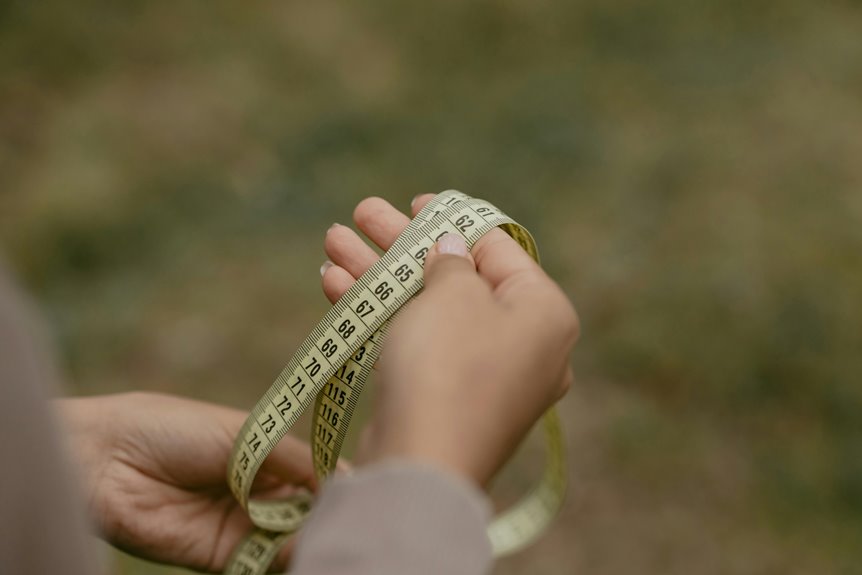When sewing with crepe fabric, start by choosing the right type—crepe de chine or georgette for softness, wool crepe for structure. Pre-wash gently to avoid shrinkage, and handle with care to prevent wrinkles. Use sharp scissors and fine pins or clips to keep edges clean. Stabilize fabric when cutting and sew with longer stitches to avoid puckering. Finish seams neatly and consider lining sheer crepes. Store fabric properly to maintain its quality. Keep going to uncover more expert tips for smooth sewing success.
Table of Contents
Key Takeaways
- Pre-wash crepe fabric in cold water to prevent shrinkage and color bleeding, then gently squeeze out water without wringing.
- Use sharp needles size 70/10 or 75/11 and fine silk pins to avoid snagging and damaging delicate fibers.
- Cut crepe with sharp scissors using smooth, continuous motions on a flat surface to prevent fraying and distortion.
- Adjust stitch length to 2.5–3 mm, lower presser foot pressure, and sew slowly with a walking foot to avoid puckering.
- Finish seams with French seams or a serger, and consider adding a lightweight lining to maintain structure and modesty.
Choose the Right Type of Crepe for Your Project
When selecting crepe fabric, you’ll want to contemplate the specific type that best suits your project’s needs.
There are several varieties like crepe de chine, crepe georgette, and wool crepe, each with unique textures and weights.
If your project calls for a lightweight, flowing garment, crepe de chine offers a smooth finish and drapes beautifully.
For something with a slightly textured, sheer feel, crepe georgette is ideal, especially for blouses or dresses.
Wool crepe, on the other hand, provides more structure and warmth, perfect for tailored suits or skirts.
Knowing the fabric’s weight and stretch will help you choose the right needle and thread later on.
Pre-Wash and Handle With Care
Selecting the right type of crepe sets a strong foundation, but proper care before sewing can make all the difference in your final garment.
Always pre-wash your crepe fabric to prevent shrinkage and color bleeding later. Use cold water and a gentle cycle or hand wash to protect the delicate texture. Avoid wringing; instead, gently squeeze out excess water and lay it flat to dry.
Crepe is prone to wrinkles and distortion, so handle it carefully when moving or pressing. Use a pressing cloth and a low heat setting to avoid damaging the fabric.
Taking these steps guarantees your crepe stays true to size and texture, making your sewing process smoother and your finished piece look professional and polished.
Use Sharp Cutting Tools
Sharp cutting tools are essential for working with crepe fabric because they guarantee clean, precise edges that prevent fraying and distortion.
Using sharp cutting tools ensures clean, precise edges on crepe fabric, preventing fraying and distortion.
When you cut with dull scissors or blades, the fabric can snag, stretch, or leave uneven edges that complicate sewing. Make sure your scissors or rotary cutter blades are razor-sharp before you begin. If you notice any tugging or uneven cuts, it’s a sign your tools need sharpening or replacing.
Always cut in smooth, continuous motions to avoid jagged edges. Using sharp tools also helps maintain the delicate texture of crepe without compressing or damaging the fibers.
Keep your cutting surface clean and flat to support crisp cuts. Sharp tools make your sewing process smoother and your finished garment look polished.
Stabilize Fabric When Cutting
Because crepe fabric tends to shift and stretch easily, you’ll want to stabilize it before cutting to guarantee accuracy. Lay your fabric on a flat surface and use weights or a non-slip mat underneath to prevent movement. Applying a light spray of fabric starch or using a fusible interfacing can also add firmness without damaging the texture. Avoid stretching the fabric as you cut to keep your pieces true to size.
| Stabilizing Method | Benefits | Tips |
|---|---|---|
| Fabric Weights | Holds fabric in place | Use evenly spaced weights |
| Non-slip Mat | Prevents sliding | Place under entire fabric |
| Light Fabric Starch | Adds temporary stiffness | Spray lightly, let dry |
| Fusible Interfacing | Permanent support | Test on scrap first |
Opt for Fine Pins or Clips
When working with crepe fabric, choose fine silk pins to avoid leaving marks or snags.
You can also try fabric clips as a gentle alternative that keeps layers secure without piercing the material.
These tools help you handle the delicate texture with care and precision.
Use Fine Silk Pins
A set of fine silk pins can make a big difference when working with crepe fabric. These pins are slender and sharp, allowing you to secure the fabric without leaving noticeable holes or causing snags.
When you pin crepe, use fine silk pins to avoid distorting the delicate texture or creating puckers. Insert them perpendicular to the seam lines to keep the fabric flat and stable.
Avoid using thick or coarse pins, as they can damage the fabric’s surface and make your sewing uneven. Keep your pins sharp and clean to prevent any accidental runs or pulls.
Using fine silk pins helps maintain the integrity of your crepe fabric, making your sewing process smoother and your finished garment look polished.
Try Fabric Clips
Fine silk pins do a great job securing crepe fabric, but fabric clips can offer an even gentler alternative to hold your pieces together without piercing the material. When you use clips, you avoid leaving holes or damaging the delicate fibers. Clips also speed up the process since you don’t have to carefully insert pins.
Here’s a quick comparison:
| Feature | Fine Pins |
|---|---|
| Fabric Damage | Minimal puncture risk |
| Precision | High |
| Speed | Moderate |
| Best For | Delicate seams |
| Feature | Fabric Clips |
| Fabric Damage | None |
| Precision | Moderate |
| Speed | Fast |
| Best For | Layered or bulky areas |
Using clips can make sewing crepe smoother and protect your fabric’s integrity.
Prevent Fabric Snags
Although crepe fabric is beautiful, it’s prone to snags that can ruin your project. To prevent this, always opt for fine pins or fabric clips when handling the material.
Regular pins with thick shafts can catch and pull the delicate fibers, creating unsightly snags or holes. Instead, choose sharp, thin pins designed specifically for lightweight fabrics—they’ll hold pieces together securely without damaging the fabric.
Alternatively, fabric clips are a great snag-free option, especially when working with multiple layers. They keep your fabric in place without piercing it, reducing the risk of pulls or runs.
Select the Appropriate Needle
Choosing the right needle makes all the difference when sewing crepe fabric. You’ll want to use a fine, sharp needle like a size 70/10 or 75/11 to prevent snagging or damaging the delicate fibers.
Avoid larger needles, which can leave permanent holes or cause runs. A universal needle usually works well, but if your crepe is particularly lightweight or finely woven, try a microtex or sharp needle for cleaner, more precise stitches.
Always replace your needle regularly—dull needles increase the risk of fabric pulls. Before you start, test your needle and thread combination on a scrap piece of crepe to guarantee smooth stitching without puckering or skipped stitches.
Selecting the right needle helps you sew with confidence and keeps your project looking flawless.
Adjust Stitch Length for Delicate Fabric
Once you’ve selected the right needle, the next step is to adjust your stitch length to suit crepe’s delicate nature.
Use a slightly longer stitch length—around 2.5 to 3 mm—to prevent puckering and fabric damage. Short stitches can cause the fabric to gather or perforate, leading to weak seams.
Test your stitch length on a scrap piece to find the sweet spot where the fabric feeds smoothly without pulling or stretching. Keep your tension moderate; too tight can distort crepe’s texture.
Use a Walking Foot for Even Feeding
Using a walking foot helps feed crepe fabric evenly, preventing unwanted shifts and puckering as you sew.
It grips both layers of fabric, making your stitching smoother and more accurate.
Be sure to choose the right walking foot compatible with your machine for the best results.
Benefits of Walking Foot
A walking foot can make a huge difference when sewing crepe fabric by ensuring even feeding through your machine. This attachment grips both the top and bottom layers of fabric, preventing slipping and misalignment.
You’ll notice smoother stitching and fewer puckers, which is essential for delicate crepe. Using a walking foot also reduces fabric stretching and distortion, helping maintain the fabric’s natural drape.
It eliminates the frustration of constantly adjusting layers while sewing, letting you focus on precise seams. Plus, it works great for matching patterns or seams on crepe, giving you professional results.
If you want cleaner, more consistent stitches with less hassle, a walking foot is a smart investment for working confidently with challenging fabrics like crepe.
Preventing Fabric Shifts
Keeping your crepe fabric layers perfectly aligned can be tricky without the right tools. A walking foot helps by feeding the top and bottom layers evenly, preventing fabric shifts that cause puckering or uneven seams.
When you use a walking foot, you’ll notice smoother stitching and better control, especially with slippery or lightweight crepe.
Here’s how it helps prevent fabric shifts:
- Moves multiple layers simultaneously, ensuring alignment
- Reduces stretching or distortion of delicate fabric
- Maintains consistent fabric feed for precise seams
- Minimizes puckering and bunching during sewing
Choosing the Right Foot
When sewing crepe fabric, selecting the right foot can make all the difference in achieving smooth, even seams. A walking foot is your best friend here because it feeds the top and bottom layers of fabric evenly, preventing shifting and puckering. This is essential since crepe tends to slip under regular presser feet. Using a standard foot might cause uneven feeding, leading to frustrating results.
Here’s a quick comparison to help you choose:
| Foot Type | Benefit |
|---|---|
| Walking Foot | Even fabric feeding |
| Standard Foot | Simple but less stable |
| Teflon Foot | Slips on sticky crepe |
Opt for a walking foot to keep your crepe layers aligned and your stitching flawless every time.
Test Stitches on Scrap Fabric
Before sewing on your crepe fabric, always test your stitches on a scrap piece first. This step helps you avoid puckering, skipped stitches, or fabric damage. By experimenting ahead, you’ll find the perfect tension and stitch length for your fabric’s delicate texture.
When testing stitches, focus on:
- Adjusting stitch length to prevent gathering or puckering
- Checking thread tension to avoid loose or tight stitches
- Trying different needle sizes to reduce fabric snags
- Observing how your sewing machine foot interacts with the fabric
Taking this extra step saves time and frustration, ensuring your project looks professional and lasts longer.
This simple step prevents frustration and guarantees a professional, long-lasting finish for your crepe projects.
Don’t skip this simple habit—it’s key to mastering crepe fabric sewing without headaches.
Use Lightweight Interfacing
When working with crepe fabric, choose a lightweight interfacing to maintain its delicate drape.
Always test the interfacing on fabric scraps to guarantee it bonds well without damaging the material.
Apply it carefully using gentle heat to avoid warping or puckering.
Choose Appropriate Interfacing Weight
Since crepe fabric is lightweight and delicate, you’ll want to choose an interfacing that matches its texture and weight. Using a heavy or stiff interfacing can weigh down the fabric, causing unwanted bulk and stiffness.
To keep your garment drapey and comfortable, opt for a lightweight interfacing designed specifically for fine fabrics.
When selecting interfacing for crepe, consider these tips:
- Choose fusible or sew-in options labeled “lightweight” or “sheer.”
- Test the interfacing’s flexibility to guarantee it won’t stiffen the fabric.
- Match the interfacing fiber content to your crepe (silk, polyester, etc.) when possible.
- Avoid heavy canvas or felt-like interfacings that can alter the fabric’s flow.
Picking the right interfacing will make your sewing experience smoother and your finished piece look polished.
Test on Fabric Scraps
Try testing your lightweight interfacing on at least two fabric scraps before applying it to your crepe garment. This step helps you gauge how the interfacing reacts with your specific crepe fabric.
Cut small pieces of your crepe and apply the interfacing, then check for any puckering, stiffness, or discoloration. You want the interfacing to support the fabric without compromising its natural drape or texture.
Testing also lets you adjust your pressing time and temperature to avoid damage. If the interfacing feels too heavy or alters the fabric’s hand, try a lighter option.
Don’t skip this step—it saves you from costly mistakes and guarantees your garment looks polished. Always prioritize gentle handling during testing to maintain your crepe’s delicate quality.
Apply With Gentle Heat
After testing your interfacing on fabric scraps, you’ll want to apply it with gentle heat to protect your crepe’s delicate texture.
Using a lightweight interfacing helps maintain the fabric’s natural drape without adding bulk. When pressing, keep your iron on a low to medium setting to avoid scorching or melting.
Here’s how to do it right:
- Use a pressing cloth to shield the fabric from direct heat.
- Avoid using steam, which can distort crepe’s texture.
- Press firmly but briefly to adhere interfacing without crushing fibers.
- Let the fabric cool completely before moving it to set the bond.
Press Gently With Low Heat
When you press crepe fabric, use low heat to prevent damage to its delicate fibers. High temperatures can scorch or flatten the fabric’s natural texture, ruining your project. Always test a scrap piece first. Use a pressing cloth to shield the fabric and avoid direct contact with the iron. Press gently without sliding the iron back and forth to maintain crepe’s distinctive crinkle.
| Tip | Reason |
|---|---|
| Use low heat setting | Protects fabric texture and fibers |
| Press, don’t iron | Prevents stretching and distortion |
| Use pressing cloth | Avoids shine and scorching |
Avoid Overstretching During Sewing
To avoid overstretching crepe fabric while sewing, make sure you stabilize it before stitching.
Choose the right needle to prevent snags, and adjust your presser foot pressure for smooth fabric feeding.
These steps help keep your fabric intact and your seams clean.
Stabilize Fabric Before Stitching
Although crepe fabric has a beautiful drape, it can easily stretch out of shape while you sew, so you’ll want to stabilize it before stitching. Taking this step prevents puckering and distortion, keeping your seams neat and your garment looking professional.
Here’s how to stabilize crepe fabric effectively:
- Use a lightweight fusible interfacing on seam allowances to add structure without bulk.
- Apply a spray stabilizer or starch to temporarily stiffen the fabric.
- Pin or clip carefully to avoid stretching the fabric as you handle it.
- Sew slowly, supporting the fabric at the feed dogs to maintain its shape.
Use Proper Needle Type
A proper needle type plays an essential role in preventing crepe fabric from overstretching during sewing. You’ll want to use a sharp, fine needle—like a size 70/10 or 80/12 universal or microtex needle—because these penetrate the fabric cleanly without causing snags or pulls.
Avoid using ballpoint needles since their rounded tips can push the fibers apart, leading to unwanted stretching or distortion. Also, regularly check your needle for dullness and replace it as needed to maintain smooth stitching.
Control Presser Foot Pressure
Three key adjustments to your sewing machine can help you control presser foot pressure and prevent overstretching crepe fabric.
Too much pressure can stretch and distort the delicate fibers, ruining your project. To keep your fabric intact, try these tips:
- Lower the presser foot pressure setting, if your machine allows it.
- Use a walking foot or a roller foot to gently guide the fabric.
- Place tissue paper or a stabilizer under the fabric to reduce drag.
- Sew slowly and avoid pulling the fabric while stitching.
Seam Finishes to Prevent Fraying
Proper seam finishes play an essential role in preventing crepe fabric from fraying and extending the life of your garment. Since crepe tends to unravel easily, you’ll want to secure your seams well.
Use a serger if you have one—it trims and finishes seams simultaneously, providing a clean, durable edge. If not, try a narrow zigzag stitch along the seam allowance to hold threads in place.
Another great option is French seams, which encase raw edges, creating neat, fray-proof finishes perfect for lightweight crepe. Additionally, pinking shears can reduce fraying but aren’t foolproof alone.
Whichever method you choose, finishing seams properly will save you from frustration and guarantee your crepe projects look polished and last longer.
Consider Lining for Sheer Crepe
When working with sheer crepe, you’ll want to contemplate adding a lining to maintain modesty and enhance the garment’s structure. Sheer crepe tends to be lightweight and translucent, so a lining not only provides coverage but also helps your piece hold its shape better.
When choosing a lining, consider these tips:
- Select a lightweight, breathable fabric like silk charmeuse or cotton voile to match crepe’s drape.
- Choose a lining color close to your crepe fabric to avoid visible contrast.
- Cut the lining slightly smaller to prevent bulk in seams.
- Attach the lining carefully with stay stitching or hand basting to avoid shifting during sewing.
Adding a lining will elevate your finished garment’s comfort and appearance without compromising crepe’s elegant flow.
Store Crepe Fabric Properly Before Use
Before you start sewing, you should store your crepe fabric carefully to preserve its texture and quality.
Keep it in a cool, dry place away from direct sunlight, which can fade and weaken the fibers. Avoid folding crepe too tightly to prevent permanent creases; instead, roll it loosely or hang it on a padded hanger.
If you need to fold it, place tissue paper between the folds to minimize pressure marks. Make certain your storage area is clean and free of dust or pests that could damage the fabric.
Always store crepe fabric separately from heavier fabrics that might crush or snag its delicate surface. Taking these simple steps guarantees your crepe will remain smooth and ready for sewing without extra hassle.
Frequently Asked Questions
Can Crepe Fabric Be Machine Washed After Sewing?
You can machine wash crepe fabric after sewing, but you should use a gentle cycle with cold water to avoid damage. Don’t forget to use mild detergent and avoid high heat when drying to keep it looking great.
How Do I Remove Wrinkles From Crepe Without Damaging It?
You can’t just toss crepe in the dryer to fix wrinkles! Instead, use a low-heat iron with a pressing cloth or hang it in a steamy bathroom. This keeps the fabric smooth without risking damage or shine.
What Types of Thread Work Best With Crepe Fabric?
You’ll want to use fine polyester or silk thread with crepe fabric because they’re strong yet smooth, preventing snags or puckering. Avoid thick or rough threads, as they can damage the delicate texture of crepe.
Is It Better to Hand-Sew or Machine-Sew Crepe Fabric?
You’ll find machine-sewing crepe faster and more consistent, but hand-sewing offers delicate control for tricky areas. Choose based on your project’s complexity and your comfort—both methods work well with careful handling.
Can Crepe Fabric Be Dyed After Sewing a Garment?
You can dye crepe fabric after sewing, but it’s tricky. Seams might absorb dye unevenly, causing color variations. To avoid this, test a small piece first or dye the fabric before sewing for consistent results.
- Is Silk a Nonwoven Fabric? - July 11, 2025
- Is Cotton Typically Woven or Nonwoven? - July 11, 2025
- Is Chenille a Woven or Nonwoven Fabric? - July 11, 2025







